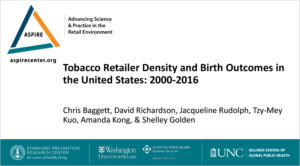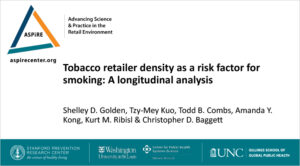Project overview
Researchers at the University of North Carolina are mapping 375,000 tobacco retailers across the U.S. from 2000 to 2017 and exploring the relationship between the density of these retailers and tobacco-related illness, like cancer.
Co-Leaders


Kurt Ribisl and Shelley Golden
“This will be a landmark study because it will finally sort out the relationship between the density of tobacco retailers, smoking prevalence, and disease. Do areas with more tobacco retailers have higher rates of smoking and cancer? Communities are starting to enact policies to reduce the number of retailers, and it is essential to understand whether that will reduce smoking, cancer, and heart disease.” — Kurt Ribisl
“There are no national lists of tobacco retailers over time. By developing and mapping a longitudinal list, we will be able to look at the kinds of communities where tobacco retailers locate and thrive, and find out if those same communities house low-income or racial and ethnic populations already at increased risk of tobacco use or associated disease.”— Shelley Golden


